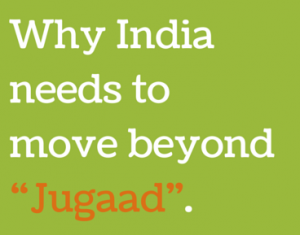
We live in a modern world – modern in thinking and modern in capabilities. Our scientists and engineers and technologists empower us with the future, in the present. The technologies they develop solve problems we didn’t even know existed. As individuals we aspire to stay apace with these ever advancing innovations. With its ubiquity in our everyday lives technology comprehensively occupies and defines our realities. Its presence in our lives assumes a position of great power. Technology is the superhero of our generation.
With great power comes great responsibility.
Currently, the benefits of technology are skewed towards those who can keep up, as opposed to those who need it most. Technology is designed to cater to the luxuries of ready made adopters. In India, a typical urban dweller has even the most trivial of her tasks solved by technology, while a person in a rural setting might struggle to meet some of his most basic needs due to a lack of access. For a superhero as powerful as technology, I think it can do better.
I work in the field of social entrepreneurship and during my career I have come across a number of beautiful examples that buck the trend; Embrace (focusing on infant mortality care); Liter of Light (bringing eco-friendly bottled light to communities without electricity); Digital Green (combining tech and social organisation to improve farming, health and nutrition) and many more. The power of such projects to improve the lives of their beneficiaries is immense. And their power depends solely on technology to solve the problem.
In my own work I have used technology to positively impact the lives of the visually impaired. With a user-centred design intention and with technology as our medium we have been able to work on a number of solutions that allow better access to smartphones for blind and visually impaired people. The fulfilment of giving joy and empowerment has been the motivation; technology has been the super-heroic protagonist.
My experience in the field has helped me understand the significance of technology to increase impact and, as crucially, to understand the interrelationship between impact and sustainability. The more sustainable a project, the greater its positive impact will be. Particularly in non-profit projects, impact tends to scale only up to a point. But as we look at works that scale, a low cost, adaptive and upgradable solution results in easier integration and a longer project lifespan. Technology plays a role not only in terms of the solution but also in terms of the operational sustainability of the enterprise.
Ideo’s elaborate Human Centred Design (HCD) toolkit sheds further light on the relationship between technology, project sustainability and impact. It states the need for a product to be desirable by its users, feasible through technology and viable as a business. In our case, design helped us create a desirable solution in the form of a specialised mobile phone for blind users, feasibility made us refine the solution into an app that addresses the same needs yet can scale at a global level and viability allowed us to adapt a business model that supports development yet keeps the price low and accessible for its intended users.
In this modern age technology plays a central role in building viable solutions that create positive impact. It defines the scale of impact by being a key factor in the sustainability of these solutions. However, in a capitalist set up as ours, there’s room for increased intervention, and thus impact, from technology. It is not yet the Robin Hood it can be.
Sumit Dagar is a social and design entrepreneur working in New Delhi, India. He was made a Rolex Awards for Enterprise Young Laureate in 2012 for his work in the field of applied technology.
The post was originally posted on The Guardian website.


 Contrary to general perception, design process strives to find the correct problems. Solution to these form the second half of the process and which has complete dependency on the earlier, yet is more celebrated.
Contrary to general perception, design process strives to find the correct problems. Solution to these form the second half of the process and which has complete dependency on the earlier, yet is more celebrated.